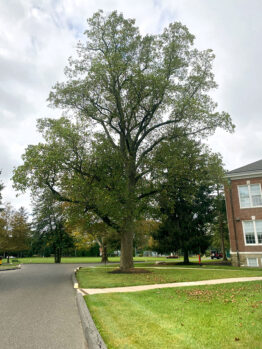Tulip Tree
Researched by Nicole Hopkins
 Species: Liriodendron tulipifera
Species: Liriodendron tulipifera
Common name: Tulip Tree, Tulip-poplar, Blue-poplar, Yellow-poplar
Family: Magnoliacae (Magnolia Family)
Clade: Angiosperms (flowering seed plants)
Coordinates: 39.7066139, -75.12027588
A tag using this number is placed near the tree.
Liriodendron tulipifera is commonly known as the tulip tree due to the cup-shaped, tulip-like flowers that it produces in late spring, but it is distantly related to other species that we might call tulips. Other common names for this tree include yellow poplar, tulip poplar, and blue poplar. This tree is a part of the Magnoliaceae family, commonly called the Magnolia family, and includes some of the oldest flowering plant lineages. This particular species is estimated to have existed for over 100 million years, long before humans inhabited Earth.
Native to Eastern North America, the tulip tree grows in 29 states and Canada. In the U.S., the species ranges from Vermont westward to Michigan and down to Florida and Louisiana. Tulip trees are frequently found in woods or along stream banks. They can thrive in various soil types but do best in moist, well-drained, loamy, and slightly acidic soils. Tulip trees prefer seasonal climates, moderate moisture, and full sun.
Fast-growing, tulip trees live up to 300 years. With a growth rate of 24 inches per year, they can grow to 90 feet or more. Larger trees can achieve a canopy spread of 40 feet at maturity. Read More
Campus Species Map
Researcher’s Biography
 Nicole Hopkins
Nicole Hopkins
Nicole Hopkins earned her Bachelor of Science in Biological Sciences in 2021.
Suggested Citation:
Hopkins, Nicole. (2021, Dec). Tulip Tree. Rowan University Arboretum. https://arboretum.rowan.edu/trees/tulip-tree/
Questions to Explore
- What characteristics of the tulip tree benefit the Eastern Tiger Swallowtail butterfly?
- Which characteristics of this tree are shared by other species in the Magnolia Family?
- How is commercial honey from the tulip tree obtained?
- Is the tulip tree bark still used medicinally today?
References
Beck , D. E. (n.d.). Liriodendron tulipifera L. Yellow-Poplar . Liriodendron tulipifera L. | Link
Liriodendron tulipifera . Liriodendron tulipifera – Plant Finder. (n.d.). | Link.
Liriodendron tulipifera. Liriodendron tulipifera (Tulip Poplar, Tulip Tree, Yellow Poplar, Yellow-Poplar) | North Carolina Extension Gardener Plant Toolbox. (n.d.). | Link
Plant database. Lady Bird Johnson Wildflower Center – The University of Texas at Austin. (n.d.). | Link
SPECIES: Liriodendron tulipifera . Liriodendron tulipifera. (n.d.). | Link
Tuliptree liriodendron tulipifera. Tuliptree Tree on the Tree Guide at arborday.org. (n.d.). | Link
Tuliptree. The Morton Arboretum. (2021, May 13). | Link
Tuliptree. Tuliptree-National Tree Candidate. (n.d.). | Link
Rowan University Resources
*You may need to log into the Rowan University Library site*
Overview of the distinctive features of tulip trees | Link
Teaching the Trees: Lessons from the Forest | Link
Radial growth responses of tulip poplar to climate in the eastern United States | Link


















